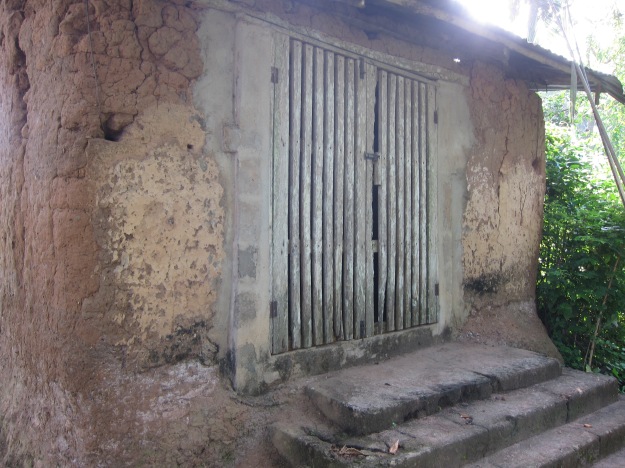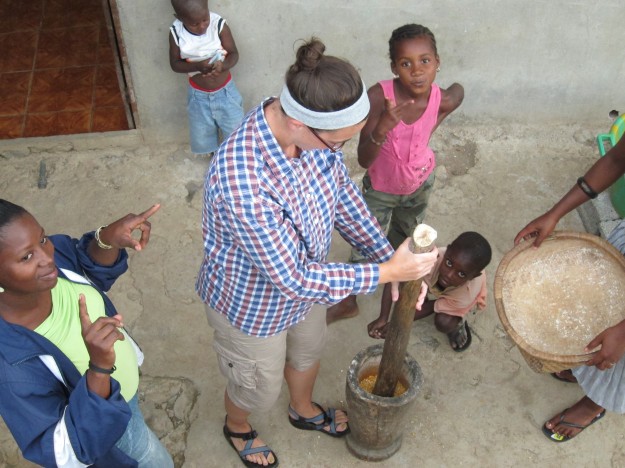When Adam and I learned where we would be living in Benin (near Porto Novo), we were handed a packet of information with a map of our commune (kind of like a county), job descriptions and a consultant’s report about the population, environment and economy. It’s rare to come by such comprehensive, professionally prepared information about your Peace Corps hometown, so I devoured this report as quickly as my French comprehension allowed. Being who I am, I started by studying the map and then I dove into the section on geology.
The area we live in is wrinkled into a series of broad, shallow valleys and wide, low ridges. The river valleys are laced with slow-flowing rivers with interwoven channels and stretches of wetland. I read through the details about ferruginous and hydromorphic soils, clay and peat deposits, and then came to a little bulleted text saying that our river valleys are home to 49 sacred forest islands, protected because they harbor the notorious Vodoun spirit named Oro.
I already heard a lot about Oro because he’s quite threatening and mysterious: he and his followers come out at night and perform secret ceremonies meant to chase away evil spirits. Before Benin was colonized, Oro functioned as society’s police force. Thieves, murderers and other bad people had to pay for their actions even though there wasn’t a judicial system like there is now. Only initiated men are allowed to see Oro. Women must stay out of sight, on pain of death. Fortunately, Oro is only active for a few weeks in August or September (depending on where you live), and word of his schedule is spread in advance (if only a few hours). Also, his entourage makes quite a racket, so he’s avoidable.
There are a couple other types of Vodoun spirits who are often out and about around here, viewable to all: Zangbeto and Egun (or Egungun). Zangbeto looks like a haystack and Egun looks like a person. In both cases, the spirits seem a lot like a person wearing a costume, but any identifiable features are covered up. However, followers claim that they have called forth spirits to inhabit the costumes, and that there are no people underneath. It’s not abnormal to come across small buildings that house these spirits. In the case of Zangbeto, the haystack often sits clearly visible through barred windows or doors. I can only speculate about Oro, but I’m guessing his outfits are stored on the sacred islands and that he’s a person dressed up for ceremonies.
Despite the intrigue surrounding Oro, I was most interested in the ecological value of his forest islands. In my Peace Corps training manuals, I had read that sacred lands like this serve the secondary purposes of protecting ecosystems and their functions. For instance, the forests and wetlands along a river valley might be reserved for ceremonial uses, with the result that they are left intact to filter water and provide feeding and nesting habitat for wildlife. In this way, the community maintains a reliable source of clean drinking water, wood (logging is permitted in some forests) and plant materials, although these aren’t the primary objectives of preserving the forest. Sacred lands can also conserve biodiversity because they are places where many types of plants are cultivated for medicinal and religious uses.
I knew that I wouldn’t be setting foot in Oro’s forests, but I tried to learn a bit more by asking around. Unfortunately, I didn’t get too far. Most people either don’t know, or don’t really find the topic of religious forests very interesting, because they’re so common and embedded into life here. Although Vodoun is a strong presence in our area, traditional practices have eroded as more people have adopted Christianity and modern medicine and have gained access to better education. However, a few weeks ago, Adam and I went with a local non-profit organization on a neighborhood walk to see an area that the organization is hoping to develop for eco-tourism. I had asked the non-profit’s leader about sacred forests before, and he mentioned to me that we would pass by one during this walk.
That day, we headed out from the mayor’s office, past the youth center and through the grounds of an elementary school. There, not even half an hour into our walk, and no more than fifty feet past the school, my guide turns to me, points, and says, “There it is. The sacred forest.”
There it was, right behind the elementary school, on a patch of land not much bigger than the city lot containing my childhood home. Not quite the vast expanse of dense woods I had imagined. I noticed a wall of vegetation enclosing a line of large, evenly spaced trees of different species. My guide laughed and wagged his finger at me. “Don’t ever go in there,” he said. “Oro is in there. Do you know what happens if a woman sees Oro?!” He laughed and walked on. Hilarious.
I stared skeptically at the forest. It seemed so average. There it was, right on the edge of town, where anybody could find it. Here in our town in Benin, a patch of forest to house an idol is on par with the storefront churches I passed by all the time in Harlem, or the local synagogue down the street from my childhood home. The believers revere it, and the nonbelievers pass by without thinking about it. I wondered how often little kids dared to sneak in and peek at Oro.
A few hundred yards further down the road, we came to an enormous tree whose buttressed roots sheltered this guy. This particular tree species is very uncommon in southern Benin, but this one is protected by its religious association.

 And pretty soon after, we looped down to the waterfront where we photographed this ominous display.
And pretty soon after, we looped down to the waterfront where we photographed this ominous display.
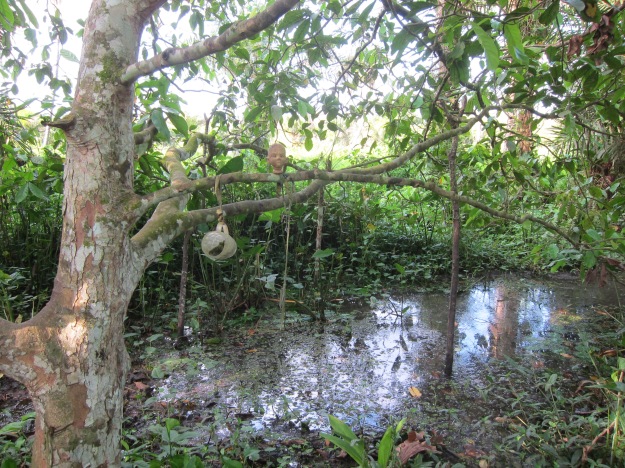 Nobody batted an eyelash as we crowded around to take photographs, nor did anyone really explain the items. (“It’s religious. This is an important spot on the water.”) We rested a bit, did some shots of palm liquor (it was 10 in the morning, but that’s hospitality), and continued on. Soon we arrived at a collection of ceremonial statuary.
Nobody batted an eyelash as we crowded around to take photographs, nor did anyone really explain the items. (“It’s religious. This is an important spot on the water.”) We rested a bit, did some shots of palm liquor (it was 10 in the morning, but that’s hospitality), and continued on. Soon we arrived at a collection of ceremonial statuary.

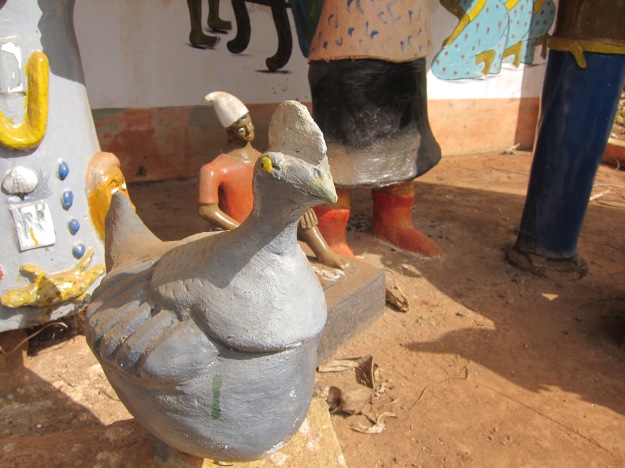
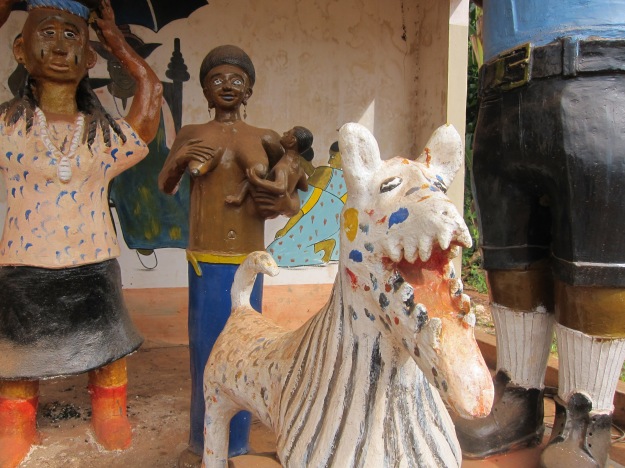 During our walk—from the unremarkable sacred land, to the unremarked-upon sacred strangeness—I had been struggling to sort it all out in my mind. Truth be told, Vodoun is just as ho-hum as any other religion. Shrines, fetishes and statues are everywhere. I can buy ceremonial goods at my local market for less than a few dollars. The other week, Adam and I bought an altar for communicating with our ancestors. We knew it was a ritual object, but we weren’t sure what sort, and we thought it would make a good souvenir to put in our garden. We haggled over its price just as we would for a pile of tomatoes (end result: $2.25). Then we carried it around the market for an hour and the only reaction we got was a vendor who demanded to know why we hadn’t bought one from her stall.
During our walk—from the unremarkable sacred land, to the unremarked-upon sacred strangeness—I had been struggling to sort it all out in my mind. Truth be told, Vodoun is just as ho-hum as any other religion. Shrines, fetishes and statues are everywhere. I can buy ceremonial goods at my local market for less than a few dollars. The other week, Adam and I bought an altar for communicating with our ancestors. We knew it was a ritual object, but we weren’t sure what sort, and we thought it would make a good souvenir to put in our garden. We haggled over its price just as we would for a pile of tomatoes (end result: $2.25). Then we carried it around the market for an hour and the only reaction we got was a vendor who demanded to know why we hadn’t bought one from her stall.
A sacred forest obviously has a rightful place in the middle of town, and it can still have ecological significance if it’s located there. The danger is that if the religious uses lose status, then the land can be appropriated for some other use. If that happens, the secondary functions are easily lost because no one is thinking about them. And on top of that, a walk through town becomes far less interesting.
